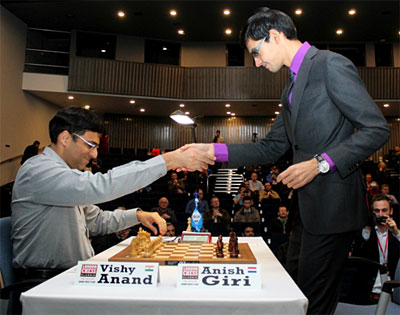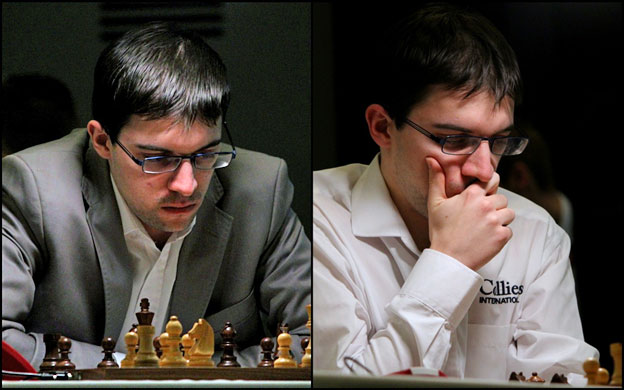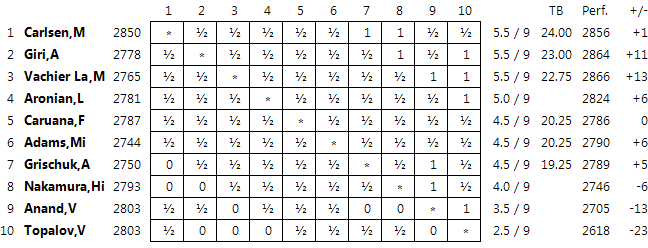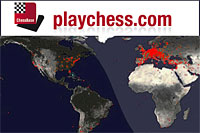
The 7th London Chess Classic, England's premier tournament, took place at its traditional venue of Kensington Olympia from Friday December 4th to Sunday December 13th. The main event, the strongest ever held in the UK, was a nine-round ten-player super tournament played at a rate of 40 moves in two hours, followed by the rest of the game in one hour, with a 30-second increment from move 41. The overall prize fund was $300,000, with the winner getting $75,000.
| Round 9 Sunday 13 Dec, 14.00-21.00 |
|
Viswanathan Anand
|
½-½
|
Anish Giri |
|
Michael Adams
|
½-½
|
Fabiano Caruana |
|
Levon Aronian
|
½-½
|
M Vachier-Lagrave |
|
Magnus Carlsen
|
1-0
|
Alexander Grischuk |
|
Hikaru Nakamura
|
½-½
|
Veselin Topalov |
A Magnuficent Sunday at LCC 2015 – Part one
Report from London by Sagar Shah and Amruta Mokal
At 11.38 p.m. Maxime Vachier Lagrave shook Carlsen’s hand, in resignation, and the World Champion became the London Chess Classic and Grand Chess Tour 2015 winner! But, wait, aren’t we getting ahead of ourselves? What exactly were the players doing until almost midnight, when the final round of the event had actually started ten hours earlier? Well, let’s rewind the clocks to 2.p.m. on Sunday afternoon of the 13th of December 2015. The ninth round of the London Chess Classic was just about to begin and no one had an inkling of the things that were about to follow! For careful eyes, however, there were already some signs of what was about to transpire!

Believe it or not, Magnus Carlsen and Maxime Vachier-Lagrave, who turned out to be the
last two men standing in the event, were ironically the first ones to arrive at the tournament hall

Michael Adams, Anish Giri and a tired Veselin Topalov before the start of the final round

Hikaru Nakamura and Vishy Anand were on 3.0 and 3.5 points and had no chance of fighting for the top spots

That's how! Magnus’s mother Sigrun turned up for the last round of the event

This is how things looked before the final round began

Anish had little difficulty in neutralizing Anand’s white pieces using, you guessed, the Berlin

[Event "7th London Classic 2015"] [Site "London ENG"] [Date "2015.12.13"] [Round "9"] [White "Anand, Viswanathan"] [Black "Giri, Anish"] [Result "1/2-1/2"] [ECO "C67"] [WhiteElo "2803"] [BlackElo "2778"] [Annotator "Sagar Shah"] [PlyCount "66"] [EventDate "2015.12.03"] 1. e4 e5 2. Nf3 Nc6 3. Bb5 Nf6 4. O-O Nxe4 5. d4 Nd6 6. Bxc6 dxc6 7. dxe5 Nf5 8. Qxd8+ Kxd8 {What do you choose in an all important game that could decide the outcome of not only the tournament but also the Grand Chess Tour? Of course, the Berlin!} 9. Nc3 Ke8 10. h3 h5 11. Bf4 Be7 12. Rad1 Be6 13. Ng5 Rh6 14. g3 {Anand has already played this position thrice with the black pieces and Giri has been in White's shoes once. But it is the first time the players are playing with the opposite colours. (Apart from Giri hqving tried it in this very tournament against MVL with black.)} Bxg5 (14... Bc4 {was played by Anish against Maxime Vachier-Lagrave in this tournament.}) 15. Bxg5 Rg6 16. h4 f6 17. exf6 gxf6 18. Bf4 Nxh4 19. f3 Rd8 20. Kf2 Rxd1 21. Nxd1 Nf5 {All of these moves and the next few are very well known and hence do not require much comments. There is nothing new under the sun.} 22. Rh1 Bxa2 23. Rxh5 Be6 24. g4 Nd6 25. Rh7 Nf7 26. Ne3 {The players have been following the game Carlsen-Anand from the 2014 World Championship match! In that game Anand played Kd8. Anish now comes up with an improvement, but it is still not a novelty.} b6 {This had been played by Bogdan Belyakov albeit only in a blitz game.} (26... Rg8 27. Bxc7 Rh8 28. Rxh8+ Nxh8 29. f4 $1 $14 {[%cal Gf4f5] and with f5 coming up White has the microscopic plus.}) 27. Ng2 $146 (27. Rh1 { was played by Motylev in that blitz game.}) (27. b3 $5 {is an improvement suggested by Giri in the press conference, but I would say it is one of those moves which doesn't really change the character of the position.}) 27... Rg8 28. Bxc7 Rh8 29. Rxh8+ (29. Rg7 Kf8 (29... Ng5 30. Bf4 Nh3+ 31. Kg3 Nxf4 32. Nxf4 Bf7 $11) 30. Rg6 Rh6 $2 (30... Ke7 $11) 31. Bd6+ $1 Ke8 32. Rg8+ Kd7 33. Bf4 $14) 29... Nxh8 30. Ne3 Nf7 31. Bg3 (31. f4 Kd7 32. Bb8 Kc8 33. f5 Bxf5 34. Bxa7 Bxc2 $11 (34... Bxg4 35. Nxg4 Kb7 36. Bxb6 Kxb6 37. Nxf6 $11)) 31... Nh6 32. Bf4 Nf7 33. Bg3 Nh6 1/2-1/2

+2 in London and +5 in the Grand Chess Tour, without a single loss – that’s the super solid Anish for you

Commentator Nigel Davies said, “We are looking at scenarios when the main games could end at something like 9 p.m. and then we would have the tiebreaks. We could be in for a long night, maybe until 3 a.m., and then if someone was to find a flaw in the tiebreak system, I cannot imagine what would happen!” To which Anand exclaimed, “That’s my dream scenario! It would be nice to wake up in the morning and read about it!”
With Anish already on 5.5/9, the onus was now on Maxime Vachier-Lagrave to play for a win in order to finish sole first at the London Chess Classic. But this was not at all easy, as first of all he was facing Aronian and secondly he had the black pieces.

[Event "7th London Classic 2015"] [Site "London ENG"] [Date "2015.12.13"] [Round "9"] [White "Aronian, Levon"] [Black "Vachier Lagrave, Maxime"] [Result "1/2-1/2"] [ECO "A04"] [WhiteElo "2781"] [BlackElo "2765"] [Annotator "Sagar Shah"] [PlyCount "66"] [EventDate "2015.12.03"] 1. Nf3 {[%emt 0:00:03]} c5 {[%emt 0:00:03]} 2. c4 {[%emt 0:00:06]} Nc6 { [%emt 0:00:02]} 3. Nc3 {[%emt 0:00:09]} e5 {[%emt 0:00:02]} 4. e3 {[%emt 0:00: 07]} Nf6 {[%emt 0:00:03]} 5. d4 {[%emt 0:00:08]} e4 {[%emt 0:00:03]} 6. d5 { [%emt 0:00:07]} exf3 {[%emt 0:00:02]} 7. dxc6 {[%emt 0:00:06]} dxc6 {[%emt 0: 00:03]} 8. Qxd8+ {[%emt 0:00:11]} Kxd8 {[%emt 0:00:03]} 9. gxf3 {[%emt 0:00:09] } Kc7 {[%emt 0:00:12]} 10. b3 {[%emt 0:00:32]} Be7 {[%emt 0:00:31]} 11. Bb2 { [%emt 0:00:35]} Rd8 {[%emt 0:00:36] Both the players reached this point quite quickly. After that Aronian sank into deep thought. Black has stopped 0-0-0. Let us try to understand the various imbalances in the position. It somehow resembles the Berlin because Black's pawn majority on the queenside doesn't seem so potent. White on the kingside has a working majority although the pawns are doubled. Meanwhile Black's development is quite smooth. He can move his bishop to e6/f5 and connect the rooks. White has to figure out where he would like to place his king. Let's see how the game proceeds.} 12. h4 $5 { [%emt 0:06:13] Planning to exchange the light squared bishops. Once the bishops are exchanged the king would feel safer on e2.} g6 {[%emt 0:04:23]} 13. Bh3 $6 {[%emt 0:05:38] This move seems logically fine but it doesn't help White to get an advantage. After the game Levon suggested a better try was to play Ne4!?} (13. Ne4 $5 Nxe4 14. fxe4 h5 15. Be5+ Bd6 16. Bc3 Be6 17. f4 $14 { and it seems like White has something to bite on.}) 13... Bxh3 {[%emt 0:14:26]} 14. Rxh3 {[%emt 0:01:47]} Kd7 $1 {[%emt 0:14:08] A very strong maneuvre underestimated by Aronian. The king stands excellently on e6.} 15. Rd1+ { [%emt 0:11:57]} Ke6 {[%emt 0:00:40]} 16. Rxd8 {[%emt 0:03:26]} Bxd8 $5 { [%emt 0:09:21]} (16... Rxd8 {would be a natural recapture but after} 17. Ke2 { the rook has no entry points on the d-file and it has to anyway return to b8 to break on the queenside.}) 17. Ke2 {[%emt 0:00:42]} Rb8 {[%emt 0:03:16] Black plans to break on the queenside with b5. If White takes it straightens out the pawn structure and if he doesn't then bxc4 would give the black rook a lot of activity.} 18. Nb1 {[%emt 0:12:20] Levon comes up with the idea to defend c4 with his knight. But it loses time.} b5 {[%emt 0:13:36]} 19. Nd2 { [%emt 0:00:06]} Ba5 {[%emt 0:00:08]} 20. Bxf6 {[%emt 0:05:41]} Bxd2 {[%emt 0: 00:08]} 21. Kxd2 {[%emt 0:01:24]} Kxf6 {[%emt 0:00:07]} 22. Kc3 {[%emt 0:00:04] } bxc4 {[%emt 0:04:56]} 23. Rh1 {[%emt 0:09:36]} (23. Kxc4 Rd8 {[%csl Rh3] Look at the poor guy on h3 completely out of the game.} 24. Kxc5 Rd2 25. a4 Rxf2 $11) (23. bxc4 Rb1 $1 $15) 23... cxb3 {[%emt 0:10:15]} 24. axb3 {[%emt 0: 00:09]} h5 {[%emt 0:08:23]} 25. Ra1 {[%emt 0:02:52]} g5 {[%emt 0:00:19]} 26. hxg5+ {[%emt 0:00:04]} Kxg5 {[%emt 0:00:07]} 27. Rxa7 {[%emt 0:00:10]} Kg6 { [%emt 0:00:31]} 28. Ra1 {[%emt 0:08:51]} h4 {[%emt 0:00:47]} 29. Kc4 {[%emt 0: 02:35]} Rb4+ {[%emt 0:02:39]} 30. Kxc5 {[%emt 0:00:09]} Rxb3 {[%emt 0:00:05]} 31. Kxc6 {[%emt 0:00:04]} Rb2 {[%emt 0:00:18]} 32. Rh1 {[%emt 0:00:09]} Rxf2 { [%emt 0:00:15]} 33. Rxh4 {[%emt 0:00:06]} Rxf3 {[%emt 0:00:07] The players agreed to a draw at this point and Maxime joined the leaders at the top.} 1/2-1/2

Maxime tried his level best, also took off his jacket, but that was not enough for the full point

Draw Maestros: the game between Michael Adams and Fabiano Caruana ended peacefully
Before the start of the game, tournament director Malcolm Pein announced that “in modern day chess, winning seven games in a row is called ‘doing a Caruana’, after his fantastic feat at the Sinquefield 2014. I wonder what they would call making nine draws on a trot. Maybe a Caruana-Adams!” It was sort of unbelievable but both Adams and Caruana made nine draws out of nine rounds at the London Chess Classic. Anish Giri was particularly happy, as he would be no longer called the most boring of the elite players: “Never, and I mean never in my life have I drawn all the games in any sort of tournament.” Of course Fabi must have been ruing his chance for missing out a win in one move against Alexander Grischuk with 46.Qg6 in the fifth round! [LINK]

Nakamura-Topalov wasn’t a particularly exciting Berlin and ended in a draw after 34 moves

The most rousing game of the round was definitely Magnus Carlsen’s win against Alexander Grischuk
With 5.5/9, Anish Giri and MVL had already booked their seats in the playoff. It was now up to either Carlsen or Grischuk to win and join them. The game began as a Sicilian Rossolimo but quickly turned wild as the Russian player repeated the same line with 7…g5!? that had been played against Carlsen by Topalov in the first round of the Sinquefield Cup 2015. It seemed like a pretty bad choice, as Carlsen clearly had a good feel for the position. He found the best moves and very soon put Grischuk under tremendous pressure. But then the World Champion began to go wrong. He took his queen far away, from the center of action, to a6, and then played in an extremely reckless fashion with Nb5. Before he even knew it, dark clouds had gathered around the white king with four black pieces attacking at the same time. Grischuk, however, was in his usual time pressure zone. He first missed a win and then many ways to draw the game. In the end he blundered and lost, allowing Magnus to join the leaders with 5.5/9.

[Event "7th London Classic 2015"] [Site "London ENG"] [Date "2015.12.13"] [Round "9"] [White "Carlsen, Magnus"] [Black "Grischuk, Alexander"] [Result "1-0"] [ECO "B51"] [WhiteElo "2850"] [BlackElo "2750"] [Annotator "Sagar Shah"] [PlyCount "73"] [EventDate "2015.12.03"] 1. Nf3 {[%emt 0:00:03] Carlsen wants to keep all the flexibilty alive in the position. He also knows that Grischuk usually replies 1...c5 to 1.Nf3. Hence, he could play 2.e4 and take it into Sicilian territory without having to worry about any Berlins.} c5 {[%emt 0:00:49]} 2. e4 $5 {[%emt 0:00:11] It's Sicilian time.} d6 {[%emt 0:00:05]} 3. Bb5+ {[%emt 0:00:03] A typical Carlsen move who would like to have a fluid position with lots of possibilities without having to worry about too much theory.} Nd7 {[%emt 0:00:23]} 4. O-O {[%emt 0:00:09]} a6 {[%emt 0:02:38]} 5. Bd3 $5 {[%emt 0:00:11] The idea is to later play c4 or c3 then drop the bishop back to c2 and then go d4.} Ngf6 {[%emt 0:01:14]} 6. Re1 {[%emt 0:00:18]} b5 {[%emt 0:03:26]} 7. c4 {[%emt 0:00:08]} g5 $5 {[%emt 0: 00:06] Grischuk goes for the same move that was played by Topalov in the first game of the Sinquefield Cup 2015 against Carlsen. It seemed like not such a successful choice as Magnus was very well prepared for this move.} 8. Nxg5 { [%emt 0:00:04]} Ne5 {[%emt 0:00:11]} 9. Be2 {[%emt 0:00:04]} bxc4 {[%emt 0:02: 01]} 10. Nc3 $146 {[%emt 0:00:02] Carlsen is the first one to deviate. In the game against Topalov he went for Na3. Grischuk went into a long think and was mainly not lookingat the chess board. Clearly he was trying to remember his analysis.} (10. Na3 Rg8 11. Nxc4 $5 Nxc4 12. d4 {led to a crazy position in Carlsen-Topalov.}) 10... Rb8 {[%emt 0:16:44] Daniel King and Nigel Davies mentioned that they were looking at the other rook moving a square sidewards. When this move was made they were pretty surprised!} 11. Rf1 $5 {[%emt 0:22:01] A very tricky move by Magnus played after 20 minutes of thought. It frees the e1 square for the g5 knight which could later exchange itself for the Black knight when it sits on d3. Also the rook on f1 supports the f-pawn to move forward.} h6 {[%emt 0:16:29]} 12. Nf3 {[%emt 0:00:08]} Nd3 {[%emt 0:00:06]} 13. Ne1 {[%emt 0:11:04]} Nxb2 {[%emt 0:11:49]} 14. Bxb2 {[%emt 0:05:54]} (14. Qc2 Nd3 15. Nxd3 cxd3 16. Bxd3 Bg7 {followed by 0-0 is nothing much for White.}) 14... Rxb2 {[%emt 0:00:20]} 15. Bxc4 {[%emt 0:00:02]} Rb4 {[%emt 0:14:21]} 16. Qe2 {[%emt 0:02:50]} Bg7 {[%emt 0:00:53]} 17. Nc2 {[%emt 0:07:25]} Rb6 { [%emt 0:00:12]} 18. Rab1 {[%emt 0:02:46]} O-O {[%emt 0:09:09]} 19. Rxb6 { [%emt 0:00:08]} Qxb6 {[%emt 0:00:06]} 20. Ne3 $14 {[%emt 0:00:06] White has a clear edge in this position. The material is even and the white pieces are simply much better placed.} e6 {[%emt 0:04:32]} 21. f4 {[%emt 0:00:08] All the English players who entered the commentary room said one and the same thing: "This is an excellent version of the Grand Prix attack!"} Kh8 {[%emt 0:09:56]} 22. f5 {[%emt 0:06:47]} a5 {[%emt 0:00:23]} 23. a4 {[%emt 0:03:28]} Qd8 { [%emt 0:00:40]} 24. h3 {[%emt 0:02:30]} Qe7 {[%emt 0:04:01]} 25. Ba6 {[%emt 0: 01:32]} Bxa6 {[%emt 0:06:30]} 26. Qxa6 {[%emt 0:00:03]} Nh5 {[%emt 0:00:17]} 27. Rf3 {[%emt 0:03:39]} Rg8 {[%emt 0:01:13]} 28. Nb5 {[%emt 0:07:45] In some ways going with the queen to a6 seemed like a dubious decision by Magnus, but this is just plain bad. The knight block's the queen's path and White has left his king all alone against the might of four black pieces! From a clearly superior position it is surprising to see Magnus in grave danger.} Be5 $1 { [%emt 0:00:11] According to Aronian if White doesn't have Ng4 now then he is just lost. But of course Magnus had calculated that Ng4 should work.} 29. Ng4 { [%emt 0:03:51]} Qh4 $1 30. fxe6 {[#]} fxe6 {Grischuk, who was short on time as usual, immediately recaptured the pawn. But he had a much stronger continuation.} (30... Rxg4 $1 31. hxg4 Qh2+ (31... Qe1+ 32. Rf1 $18) 32. Kf1 Nf4 $19 {and White's position is just crumbling to pieces.}) (30... Nf4 $5 { is also interesting when the only way to survive for White is to find the move} 31. Kf1 $1 fxe6 $11) 31. Nxe5 (31. Nxd6 Bd4+ 32. Ne3 Qe1+ 33. Qf1 Qxd2 $13) 31... dxe5 (31... Qe1+ $1 32. Rf1 (32. Kh2 Ng3 33. Ng4 Ne2 $19) 32... Rxg2+ 33. Kxg2 Qg3+ 34. Kh1 Qxh3+ 35. Kg1 Qg3+ {is a draw by perpetual.}) 32. Qxe6 Qe1+ $2 (32... Qg5 33. g4 Nf4 $132 {would have led to a position with mutual chances.}) 33. Rf1 $1 (33. Kh2 Rxg2+ 34. Kxg2 Qe2+ 35. Rf2 Nf4+ 36. Kg3 Qxf2+ 37. Kxf2 Nxe6 38. Nd6 $18 {is also a better endgame for White.}) 33... Rxg2+ 34. Kxg2 Qxd2+ 35. Kg1 Qe3+ {[%emt 0:00:02]} 36. Rf2 {[%emt 0:01:08]} Qe1+ { [%emt 0:01:22]} 37. Kg2 {[%emt 0:00:14] The checks have come to an end and Grischuk has to resign the game.} 1-0

The ChessBase cloud function Let's Check shows us the win instantaneosly – it was calculated
(up to 37 ply!) by the strongest engines running on the most powerful computers in the world.

Nothing can distract me now! Grischuk gets rid of his sweater
as his position against Magnus Carlsen became too hot to handle!

There is just no way you can keep the World Champion out of the thick of the action!
Final standings after nine rounds

Three players had qualified for the tiebreak playoffs. The reason why Magnus Carlsen was sitting pretty at the top was because he had defeated Alexander Grischuk who had more points than Hikaru Nakamura, Vishy Anand or Veselin Topalov whom Anish Giri and MVL had defeated. That’s the Sonneborn-Berger system in effect. The stage was thus set – Anish and Maxime would indulge in two rapid games of 25 minutes + 5 seconds increment, followed by an Armageddon in case of a tie, and the winner would take on Magnus Carlsen for another similar match for the London Chess Classic title.
-- Part two looking at the tiebreak drama indepth will follow tomorrow –
Schedule and results of the London Chess Classic 2015
| Round 1 Friday 4 Dec, 16.00-23.00 |
|
Veselin Topalov
|
0-1
|
Anish Giri |
|
Alexander Grischuk
|
½-½
|
Hikaru Nakamura |
|
M Vachier-Lagrave
|
½-½
|
Magnus Carlsen |
|
Fabiano Caruana
|
½-½
|
Levon Aronian |
|
Viswanathan Anand
|
½-½
|
Michael Adams |
|
|
| Round 2 Sat. 5 Dec, 14.00-21.00 |
|
Anish Giri
|
½-½
|
Michael Adams |
|
Levon Aronian
|
½-½
|
Viswanathan Anand |
|
Magnus Carlsen
|
½-½
|
Fabiano Caruana |
|
Hikaru Nakamura
|
½-½
|
M Vachier-Lagrave |
|
Veselin Topalov
|
½-½
|
Alexander Grischuk |
|
| Round 3 Sunday 6 Dec, 14.00-21.00 |
|
Alexander Grischuk
|
½-½
|
Anish Giri |
|
M Vachier-Lagrave
|
1-0
|
Veselin Topalov |
|
Fabiano Caruana
|
½-½
|
Hikaru Nakamura |
|
Viswanathan Anand
|
½-½
|
Magnus Carlsen |
|
Michael Adams
|
½-½
|
Levon Aronian |
|
|
| Round 4 Monday 7 Dec, 16.00-23.00 |
|
Anish Giri
|
½-½
|
Levon Aronian |
|
Magnus Carlsen
|
½-½
|
Michael Adams |
|
Hikaru Nakamura
|
1-0
|
Viswanathan Anand |
|
Veselin Topalov
|
½-½
|
Fabiano Caruana |
|
Alexander Grischuk
|
½-½
|
M Vachier-Lagrave |
|
| Round 5 Tuesday 8 Dec, 16.00-23.00 |
|
M Vachier-Lagrave
|
½-½
|
Anish Giri |
|
Fabiano Caruana
|
½-½
|
Alexander Grischuk |
|
Viswanathan Anand
|
1-0
|
Veselin Topalov |
|
Michael Adams
|
½-½
|
Hikaru Nakamura |
|
Levon Aronian
|
½-½
|
Magnus Carlsen |
|
|
|
Wednesday 9 Dec – Free day
|
|
| Round 6 Thursday 10 Dec, 16.00-23.00 |
|
Anish Giri
|
½-½
|
Magnus Carlsen |
|
Hikaru Nakamura
|
½-½
|
Levon Aronian |
|
Veselin Topalov
|
½-½
|
Michael Adams |
|
Alexander Grischuk
|
1-0
|
Viswanathan Anand |
|
M Vachier-Lagrave
|
½-½
|
Fabiano Caruana |
|
|
| Round 7 Friday 11 Dec, 16.00-23.00 |
|
Fabiano Caruana
|
½-½
|
Anish Giri |
|
Viswanathan Anand
|
0-1
|
M Vachier-Lagrave |
|
Michael Adams
|
½-½
|
Alexander Grischuk |
|
Levon Aronian
|
1-0
|
Veselin Topalov |
|
Magnus Carlsen
|
1-0
|
Hikaru Nakamura |
|
| Round 8 Saturday 12 Dec, 14.00-21.00 |
|
Anish Giri
|
1-0
|
Hikaru Nakamura |
|
Veselin Topalov
|
½-½
|
Magnus Carlsen |
|
Alexander Grischuk
|
½-½
|
Levon Aronian |
|
M Vachier-Lagrave
|
½-½
|
Michael Adams |
|
Fabiano Caruana
|
½-½
|
Viswanathan Anand |
|
|
| Round 9 Sunday 13 Dec, 14.00-21.00 |
|
Viswanathan Anand
|
½-½
|
Anish Giri |
|
Michael Adams
|
½-½
|
Fabiano Caruana |
|
Levon Aronian
|
½-½
|
M Vachier-Lagrave |
|
Magnus Carlsen
|
1-0
|
Alexander Grischuk |
|
Hikaru Nakamura
|
½-½
|
Veselin Topalov |
|
Links
The games are being broadcast live on the official web site and on the chess server Playchess.com. If you are not a member you can download a free Playchess client there and get immediate access. You can also use ChessBase or any of our Fritz compatible chess programs. |
|










































